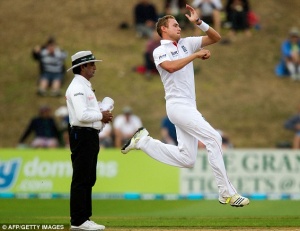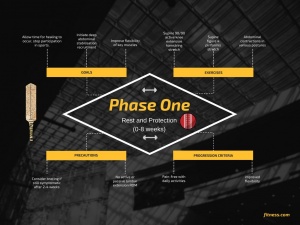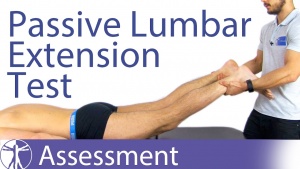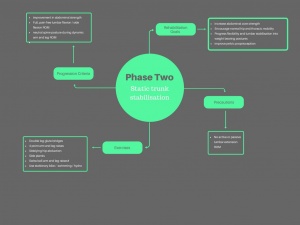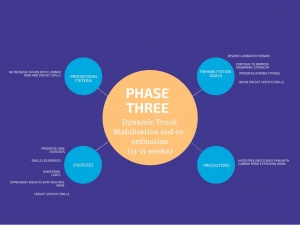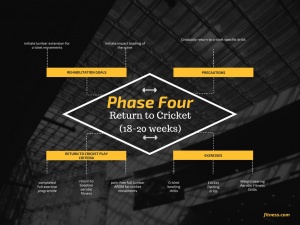Exercise Therapy in the Rehabilitation of Spondylolisthesis in Fast Bowlers in Cricket: Difference between revisions
Sam Mellor (talk | contribs) (pictures included in phase one and two) |
Sam Mellor (talk | contribs) mNo edit summary |
||
| Line 70: | Line 70: | ||
It is important to monitor progression throughout rehabilitation phases using outcome measures, tests or exercises to do this. Literature shows that using exercises incorporated in the rehab protocol is quicker, and can be more motivating for the athlete (Ferrari, Vanti and O’Reilly, 2012). An aspect that will be constantly monitored is pain. It is essential that all exercises in phase one and two are pain-free, so if anything is painful, regress the exercises until pain-free. A number of tests are recommended to be used for athletes. For instability, the prone instability test and the passive lumbar extension test. Muscle tests that can be used include the active straight leg raise, hamstring 90/90 test, double leg and single leg bridge. For abdominal strength, the plank and side plank will be a measure. | It is important to monitor progression throughout rehabilitation phases using outcome measures, tests or exercises to do this. Literature shows that using exercises incorporated in the rehab protocol is quicker, and can be more motivating for the athlete (Ferrari, Vanti and O’Reilly, 2012). An aspect that will be constantly monitored is pain. It is essential that all exercises in phase one and two are pain-free, so if anything is painful, regress the exercises until pain-free. A number of tests are recommended to be used for athletes. For instability, the prone instability test and the passive lumbar extension test. Muscle tests that can be used include the active straight leg raise, hamstring 90/90 test, double leg and single leg bridge. For abdominal strength, the plank and side plank will be a measure. | ||
[[File:Passive lumbar extension test.jpg|center|thumb|Picture of Passive Lumbar Extension Test]] | [[File:Passive lumbar extension test.jpg|center|thumb|Picture of Passive Lumbar Extension Test]] | ||
(PhysioTutors, 2017) - picture reference | |||
Exercises included in phase two are: | Exercises included in phase two are: | ||
| Line 87: | Line 89: | ||
[[File:Phase three.jpg|center|thumb|Phase Three - Dynamic Trunk Stabilisation and Co-ordination]] | [[File:Phase three.jpg|center|thumb|Phase Three - Dynamic Trunk Stabilisation and Co-ordination]] | ||
==== '''Phase Four''' - blah blah blah | ==== '''Phase Four''' - blah blah blah ==== | ||
[[File:Phase four.jpg|center|thumb|Phase Four - Return to Cricket]] | [[File:Phase four.jpg|center|thumb|Phase Four - Return to Cricket]] | ||
{{pdf|Spondylolisthesisrehabilitationprogramme.pdf|Download full Exercise Therapy Rehabilitation Programme}} | {{pdf|Spondylolisthesisrehabilitationprogramme.pdf|Download full Exercise Therapy Rehabilitation Programme}} | ||
== Suggested Exercises == | == Suggested Exercises == | ||
https://youtu.be/pgc5K_GkgTo - Please click here to see a video of suggested exercises based upon current literature for Cricketers with Spondylolisthesis. | |||
== Future Recommendations == | == Future Recommendations == | ||
Revision as of 19:37, 27 May 2018
Introduction[edit | edit source]
blah blah blah
Objectives[edit | edit source]
- Discuss pathology and epidemiology of spondylolisthesis in cricketers
- Provide an in-depth evidence-based, Exercise Therapy Rehabilitation programme for cricketers
Pathology and Classification[edit | edit source]
blah blah blah
Epidemiology[edit | edit source]
blah blah blah
Biomechanics of Bowling[edit | edit source]
blah blah blah
Indications for Surgery[edit | edit source]
blah blah blah
Exercise Therapy[edit | edit source]
Exercise Therapy is part of the conservative approach that is recommended for some athletes who have a spondylolisthesis. It is important as a physiotherapist to ensure that athletes have had medical clearance from a doctor before beginning a rehabilitation programme. Here we will discuss the Exercise Therapy programme that we have created based upon current literature/protocols that pre-exist (for athletes) for a cricketer (Uwhealth.org,2018; Nau, Hanney and Kolber, 2008).
(Mail-Online,2013) - picture reference
Phase One - ‘Rest and Protection’.[edit | edit source]
The rehabilitation goals of this stage are:
- allow adequate time for healing to occur
- initiate abdominal and spinal stabilisers
- Improve flexibility of key muscles
For healing to occur, there needs to be a period of rest. This component where agrravating activities are stopped is consistent throughout literature. A comprehensive review discussed management of low-grade spondylolisthesis in athletes. They included 14 studies investigating conservative treatment. They argued that rest is essential for management. In soccer athletes, they found that athletes who underwent activity modification as treatment rather than rest had worse outcomes in terms of return to sport in terms of time loss, but also in pain and function (Bouras and Korovessis, 2015) . Iwamoto (2010) in his return to sport article also agreed that a period of rest should be included, and that the aim is to be pain free during daily routine activities before any sport-specific exercises or strengthening exercises occur. It is this rest period that enables athletes to return pain-free to competition. Expert John Orchard who is chief medical officer for Australia Cricket reported that it is crucial that we unload our athletes before we carry out rehabilitation. The controversial point in the literature is on the duration of rest, some saying 4-6 weeks and others arguing up to 3 months.
There is debate in literature with regard to bracing during this period of rest. Literature suggests that bracing is considered if the athlete is still symptomatic after 2-4 weeks. However in a recent meta-analysis, they have reported that bracing is ineffective on outcomes. The aim of rest is to reduce extension stress of the lumbar spine and to promote anti-lordotic posture, so some authors believe bracing can help (Klein, Mehlmann and McCarty, 2009).
Next goal was to start to include core stabilisation exercises. From experts opinion, athletes tend to focus on the larger muscle groups and neglect the muscles (transverse abdominis, paraspinals, internal and external obliques, rectus abdominus and multifidus) responsible for spinal stabilisation. Strengthening these muscles can provide support by lifting the spine and maintaining neutral pelvic alignment thus transferring the force and thereby decreasing the amount of load to the area. Furthermore, transverse abdominis and multifidus have local stabilisation able to prevent excessive movements at regions of instability or hypermobility. These two groups of muscles will co-contract to provide a balanced effect in the spine. Multifidus is a deep muscle which attaches directly into the vertebra, therefore it is crucially important we provide exercises to work this muscle (Nau, Hanney and Kolber, 2008). A systematic review on risk factors and successful interventions for cricket related LBP recommended stabilisation exercises to reduce pain and increase the anterior abdominal slide (Morton et al., 2013).
The final goal was to improve flexibility of the key muscles. Standaert and Herring (2007) explain the importance for a broader kinetic chain assessment (pelvic and hamstrings, glutes) . Flexibility is an important component of spinal conditioning programs. Sometimes athletes may present with a secondary finding of hamstring or paraspinal muscle tightness perhaps to offer some sort of stabilisation. Exercises to address flexibility of the hamstrings, rectus femoris and tensor sascia latae musculature have been recognised as an integral component of the spinal conditioning program in those with spondylolitic disorders. This tightness can increase the lumbar lordosis due to direct effects on pelvic alignment, increasing strain on already unstable vertebrae. Static stretching is advocated for a duration of 30 seconds for 3 repetitions, twice a day, daily. With all of the stretches we have prescribed or recommended we are looking for it to remain pain-free. If a stretch induces pain, relieve pressure until pain-free and start again (Nau, Hanney and Kolber, 2008).
During this phase, it is crucial that athletes avoid lumbar extension to avoid stressing the lumbar spine. The duration of the first stage varies amongst different athletes. It is important that there is adequate time left to rest and be pain-free to allow healing to occur before progression onto the second phase (Perrin, 2016).
Exercises include in this phase are:
- Dynamic Hamstring 90/90 stretch
- Supine figure four Piriformis stretch
- Transverse Abdominis contractions in prone, supine and standing postures
See a summary of phase one below:
Phase Two - 'Static Trunk Stabilisation'.[edit | edit source]
The rehabilitation goals of this stage are:
- Increase abdominal strength
- Encourage normal hip and thoracic mobility
- Progress flexibility and spinal stabilisation
- Improve pelvic proprioception
Experts argue that early stages of strengthening exercises should be supervised and well-educated to ensure that technique is mastered and exercises are improving the correct components you are aiming for (Mallac, 2012).
Strengthening exercises are regarded as important. A systematic review (Hardwick et al., 2012) investigating outcomes of strengthening approaches for low grade spondylolisthesis found that both strengthening and stabilisation exercises are important and can be of benefit. It shared the view of other experts that strengthening programmes significantly improve pain and stabilisation exercises reduce disability (Miller, 2018).
Phase two builds upon the foundations that you have laid from phase one (see above). This phase is looking to further progress flexibility of key muscles of the kinetic chain (hamstrings, hip flexors), in order to further optimise pelvic alignment and prevent any further stress on the lumbar spine. The same exercise prescription advice is given as in phase one (see above)
There are progressions of the core stabiliser exercises used to further work on stabilising the spine aiming to reduce pain and disability in order. Stuart McGill (McGill, 2007) believes that lumbar stabilisation exercises are crucial for athletes with LBP as they can lead to optimal athletic performance reducing pain. He suggested core stabilisation exercises in different postures help adapt to function and different environments that athletes are required to work in. He argued that an exercise programme addressing multifidus can pull the vertebra backwards . Another systematic review agrees that they can reduce pain and disability (Garet et al., 2013). These exercises initially should be performed daily to improve neural activation and motor unit recruitment, then as time progresses and pain and disability is reduced performed 2-3 times a week to improve muscular performance. With each core stability exercise, I would recommend 10-15 repetitions of 1 set, aiming to progress up to 3 sets (McGill, 2007).
It is important to monitor progression throughout rehabilitation phases using outcome measures, tests or exercises to do this. Literature shows that using exercises incorporated in the rehab protocol is quicker, and can be more motivating for the athlete (Ferrari, Vanti and O’Reilly, 2012). An aspect that will be constantly monitored is pain. It is essential that all exercises in phase one and two are pain-free, so if anything is painful, regress the exercises until pain-free. A number of tests are recommended to be used for athletes. For instability, the prone instability test and the passive lumbar extension test. Muscle tests that can be used include the active straight leg raise, hamstring 90/90 test, double leg and single leg bridge. For abdominal strength, the plank and side plank will be a measure.
(PhysioTutors, 2017) - picture reference
Exercises included in phase two are:
- Double leg gluteal bridges
- Side-lying Clam
- Side-lying Hip abduction (ensuring no lumbar extension)
- Side Plank
- Superman Transverse Abdominis Progression (Bird-Dog) (ensuring no lumbar extension)
- Swiss Ball Leg and Arm Raises
- Plank
- Pelvic Proprioception Exercises
- Flexibility exercises from phase one
See a summary of phase two below:
Phase Three - blah blah blah[edit | edit source]
Phase Four - blah blah blah[edit | edit source]
Download full Exercise Therapy Rehabilitation Programme
Suggested Exercises[edit | edit source]
https://youtu.be/pgc5K_GkgTo - Please click here to see a video of suggested exercises based upon current literature for Cricketers with Spondylolisthesis.
Future Recommendations[edit | edit source]
blah blah blah
Clinical Bottom Line[edit | edit source]
blah blah blah
